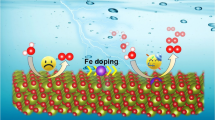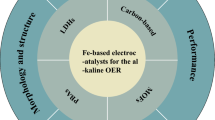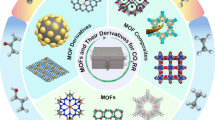Abstract
As one of the major greenhouse gases, CO2 is significantly influencing global climate change. Efficient utilization of CO2 is considered an important approach to address the current environmental and energy challenges. In particular, using CO2 as a raw material for the production of hydrocarbons is an attractive strategy for reducing carbon emissions while ensuring a stable energy supply. In this study, fluorine (F) doped ZnLa layered double hydroxide (F-ZL-LDH) and F-doped ZnCe layered double hydroxide (F-ZC-LDH) were prepared using a hydrothermal synthesis method. The materials’ structural composition and morphology were analyzed using X-ray diffractometry (XRD), X-ray photoelectron spectroscopy (XPS), scanning electron microscopy (SEM), and transmission electron microscopy (TEM). The research results demonstrate that both catalysts exhibit abundant active sites, high selectivity, and excellent electrocatalytic performance for CO2RR to generate CO, with Faradaic efficiencies reaching 89.29% and 89.87% for F-ZL-LDH and F-ZC-LDH, respectively. The doping of fluorine results in the presence of numerous defects and pore structures on the surfaces of F-ZC-LDH and F-ZL-LDH, increasing the surface active area and enhancing charge transfer rates. Meanwhile, F doping facilitates CO2 adsorption and mass transfer on the electrode surface. Moreover, F doping in the catalysts also restricts the adsorption and desorption of *H during the competing hydrogen evolution reaction (HER) process.
Graphical Abstract
The effective management and rapid conversion of CO2 to various organic compounds and chemical fuels to facilitate carbon cycle and reduce atmospheric CO2 concentration have become a hot topic in current technological advances worldwide. Among the various electrocatalytic CO2 reduction reaction (CO2RR) products, carbon monoxide (CO) is the product with the highest kinetic accessibility. In this paper, F-ZL-LDH and F-ZC-LDH composite materials were prepared using a hydrothermal synthesis method. Based on preliminary studies, a molar ratio of M2+:M3+ of 3:1 was determined to provide better catalytic performance,and ammonium fluoride content of 30% of the cation molar ratio of M2+ + M3+. The introduction of fluorine (F) improves the catalytic performance of both materials, with a greater enhancement observed for ZL-LDH. At − 1.3V vs. RHE potential, The research results demonstrate that both catalysts exhibit abundant active sites, high selectivity, and excellent electrocatalytic performance for CO2RR to generate CO, with Faradaic efficiencies reaching 89.29% and 89.87% for F-ZL-LDH and F-ZC-LDH, respectively. the fluorination treatment of ZC-LDH and ZL-LDH catalysts significantly enhances their electrocatalytic activity for the CO2 reduction reaction, particularly for the production of CO. These findings contribute to the development of efficient catalysts for CO2 electrochemical reduction and hold promise for advancing the field of CO2 utilization and renewable energy conversion.












Similar content being viewed by others
References
Dang Le Tri N et al (2020) Progress in development of electrocatalyst for CO2 conversion to selective CO production. Carbon Energy 2(1):72–98
Ma L et al (2023) Enhanced electroreduction of CO2 to C2+ fuels by the synergetic effect of polyaniline/CuO nanosheets hybrids. Nano Res 16(7):9065–9072
De Luna P et al (2019) What would it take for renewably powered electrosynthesis to displace petrochemical processes. Science 364(6438):eaav3506
Hori Y (2008) Electrochemical CO2 reduction on metal electrodes. In: Vayenas CG, White RE, Gamboa-Aldeco ME (eds) Modern aspects of electrochemistry. Springer, New York, pp 89–189
Scavetta E et al (2016) Effect of the synthesis route and Fe presence on the redox activity of Ni in layered double hydroxides. ChemElectroChem 3(9):1320–1328
Deng X et al (2019) Recent progress in functionalized layered double hydroxides and their application in efficient electrocatalytic water oxidation. J Energy Chem 32:93–104
Tang H et al (2017) Bimetallic Ni–Fe catalysts derived from layered double hydroxides for CO methanation from syngas. Front Chem Sci Eng 11(4):613–623
Singh P, Nagarajan R (2015) Synthesis and characterization of hydrotalcite type structure containing Zn2+ and La3+-ions. Mater Lett 159:58–60
Chen Y et al (2022) Boosting faradaic efficiency of CO2 electroreduction to CO for Fe−N−C single-site catalysts by stabilizing Fe3+ sites via F-doping. Nano Res 15(9):7896–7902
Hsieh Y-C et al (2019) Modification of CO2 reduction activity of nanostructured silver electrocatalysts by surface Halide Anions. ACS Appl Energy Mater 2(1):102–109
Nguyen DLT et al (2018) Effect of halides on nanoporous Zn-based catalysts for highly efficient electroreduction of CO2 to CO. Catal Commun 114:109–113
Varela AS et al (2016) Tuning the catalytic activity and selectivity of Cu for CO2 electroreduction in the presence of Halides. ACS Catal 6(4):2136–2144
Chen T et al (2020) Facile preparation of high conductive silver electrodes by dip-coating followed by quick sintering. R Soc Open Sci. https://doi.org/10.1098/rsos.191571
Liu Q-F et al (2018) Building surface defects by doping with transition metal on ultrafine TiO2 to enhance the photocatalytic H2 production activity. Chin J Catal 39(3):542–548
Xiong X et al (2020) Selective photocatalytic CO2 reduction over Zn-based layered double hydroxides containing tri or tetravalent metals. Sci Bull 65(12):987–994
Tzompantzi F et al (2020) Preparation and characterization of the polycrystalline material Zn5(OH)6(CO3)2. Determination of the active species in oxide-reduction processes. Fuel 281:118471
Kim YS et al (2009) Localized electronic states induced by defects and possible origin of ferroelectricity in strontium titanate thin films. Appl Phys Lett 10(1063/1):3139767
Casella IG et al (1999) Voltammetric and XPS investigations of nickel hydroxide electrochemically dispersed on gold surface electrodes. J Electroanal Chem 462(2):202–210
Harvey DT, Linton RW (1984) X-ray photoelectron spectroscopy (XPS) op adsorbed zinc on amorphous hydrous ferric oxide. Colloids Surf 11(1):81–96
Jung D-R et al (2011) Review paper: Semiconductor nanoparticles with surface passivation and surface plasmon. Electron Mater Lett 7(3):185–194
Liu T et al (2023) F and N codoped bimetallic oxide-reduced graphene oxide composite electrode FN-NA-CLDH@RGO for electrocatalytic reduction of CO2 to CO. Energy Technol. https://doi.org/10.1002/ente.202201160
Sinhamahapatra A et al (2012) A rapid and green synthetic approach for hierarchically assembled porous ZnO nanoflakes with enhanced catalytic activity. J Mater Chem 22(33):17227–17235
Chen BB et al (2023) Phosphorescent LaCO3OH core-satellite superstructures with highly efficient photocatalysis. Mater Today Sustainability. https://doi.org/10.1016/j.mtsust.2022.100290
Wang C et al (2023) Phase engineering oriented defect-rich amorphous/crystalline RuO2 nanoporous particles for boosting oxygen evolution reaction in acid media. Nano Res Energy 2:e9120070
Li J-X et al (2022) Nanoporous trimetallic PdCuAg alloys as efficient electrocatalysts by all-direction accessibility and synergetic effects. J Mater Chem A 10(12):6569–6575
Li W et al (2012) Formation of crystalline Zn–Al layered double hydroxide precipitates on γ-alumina: the role of mineral dissolution. Environ Sci Technol 46(21):11670–11677
Zhu W et al (2020) Insight into catalytic properties of Co3O4–CeO2 binary oxides for propane total oxidation. Chin J Catal 41(4):679–690
Gou W et al (2022) Long-range and short-range structures of multimetallic layered double hydroxides. J Phys Chem C 126(11):5311–5322
Du D et al (2022) Mesoporous PdBi nanocages for enhanced electrocatalytic performances by all-direction accessibility and steric site activation. Chem Sci 13(13):3819–3825
Yan Z et al (2018) Rapid low-temperature synthesis of perovskite/carbon nanocomposites as superior electrocatalysts for oxygen reduction in Zn-air batteries. Nano Res 11(6):3282–3293
Acknowledgements
This work was financially supported by the Chinese National Natural Science Foundation (U20A20125), the Foreign experts project of Ningxia Hui Autonomous Region, the Innovation team of clean energy and green chemical Engineering, State Ethnic Affairs Commission, and the Ningxia low-grade resource high-value utilization and environmental chemical integration technology innovation team project, North Minzu University.
Author information
Authors and Affiliations
Contributions
JW and TL: conceived and designed the experiments; JW: performed the experiments; TL: supplied the condition of experiments; RX and YZ: helped some results analysis and discussion; JW and TL: cooperated to complete the paper.
Corresponding author
Ethics declarations
Conflict of interest
The authors declare that they have no competing interests.
Additional information
Publisher's Note
Springer Nature remains neutral with regard to jurisdictional claims in published maps and institutional affiliations.
Rights and permissions
Springer Nature or its licensor (e.g. a society or other partner) holds exclusive rights to this article under a publishing agreement with the author(s) or other rightsholder(s); author self-archiving of the accepted manuscript version of this article is solely governed by the terms of such publishing agreement and applicable law.
About this article
Cite this article
Wang, J., Liu, T., Xu, R. et al. Effect of F Doping on CO2 Electrocatalytic Performance of Zinc-Based Rare Earth Layered Double Hydroxides. Catal Lett (2024). https://doi.org/10.1007/s10562-023-04526-5
Received:
Accepted:
Published:
DOI: https://doi.org/10.1007/s10562-023-04526-5




